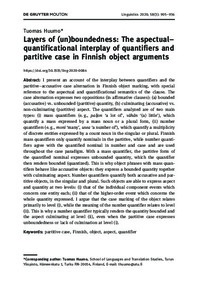Layers of (un)boundedness: The aspectual– quantificational interplay of quantifiers and partitive case in Finnish object arguments
Huumo Tuomas
https://urn.fi/URN:NBN:fi-fe2021042822721
Tiivistelmä
I present an account of the interplay between quantifiers and the
partitive–accusative case alternation in Finnish object marking, with special
reference to the aspectual and quantificational semantics of the clause. The
case alternation expresses two oppositions (in affirmative clauses): (a) bounded
(accusative) vs. unbounded (partitive) quantity, (b) culminating (accusative) vs.
non-culminating (partitive) aspect. The quantifiers analyzed are of two main
types: (i) mass quantifiers (e. g., paljon ‘a lot of’, vähän ‘(a) little’), which
quantify a mass expressed by a mass noun or a plural form, (ii) number
quantifiers (e. g., moni ‘many’, usea ‘a number of’), which quantify a multiplicity
of discrete entities expressed by a count noun in the singular or plural. Finnish
mass quantifiers only quantify nominals in the partitive, while number quantifiers
agree with the quantified nominal in number and case and are used
throughout the case paradigm. With a mass quantifier, the partitive form of
the quantified nominal expresses unbounded quantity, which the quantifier
then renders bounded (quantized). This is why object phrases with mass quantifiers
behave like accusative objects: they express a bounded quantity together
with culminating aspect. Number quantifiers quantify both accusative and partitive
objects, in the singular and plural. Such objects are able to express aspect
and quantity at two levels: (i) that of the individual component events which
concern one entity each; (ii) that of the higher-order event which concerns the
whole quantity expressed. I argue that the case marking of the object relates
primarily to level (i), while the meaning of the number quantifier relates to level
(ii). This is why a number quantifier typically renders the quantity bounded and
the aspect culminating at level (ii), even when the partitive case expresses
unboundedness or lack of culmination at level (i).
Kokoelmat
- Rinnakkaistallenteet [19218]
